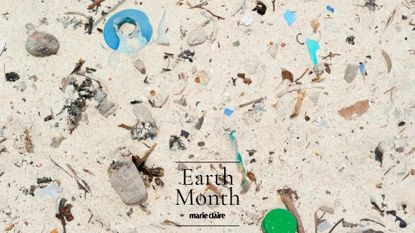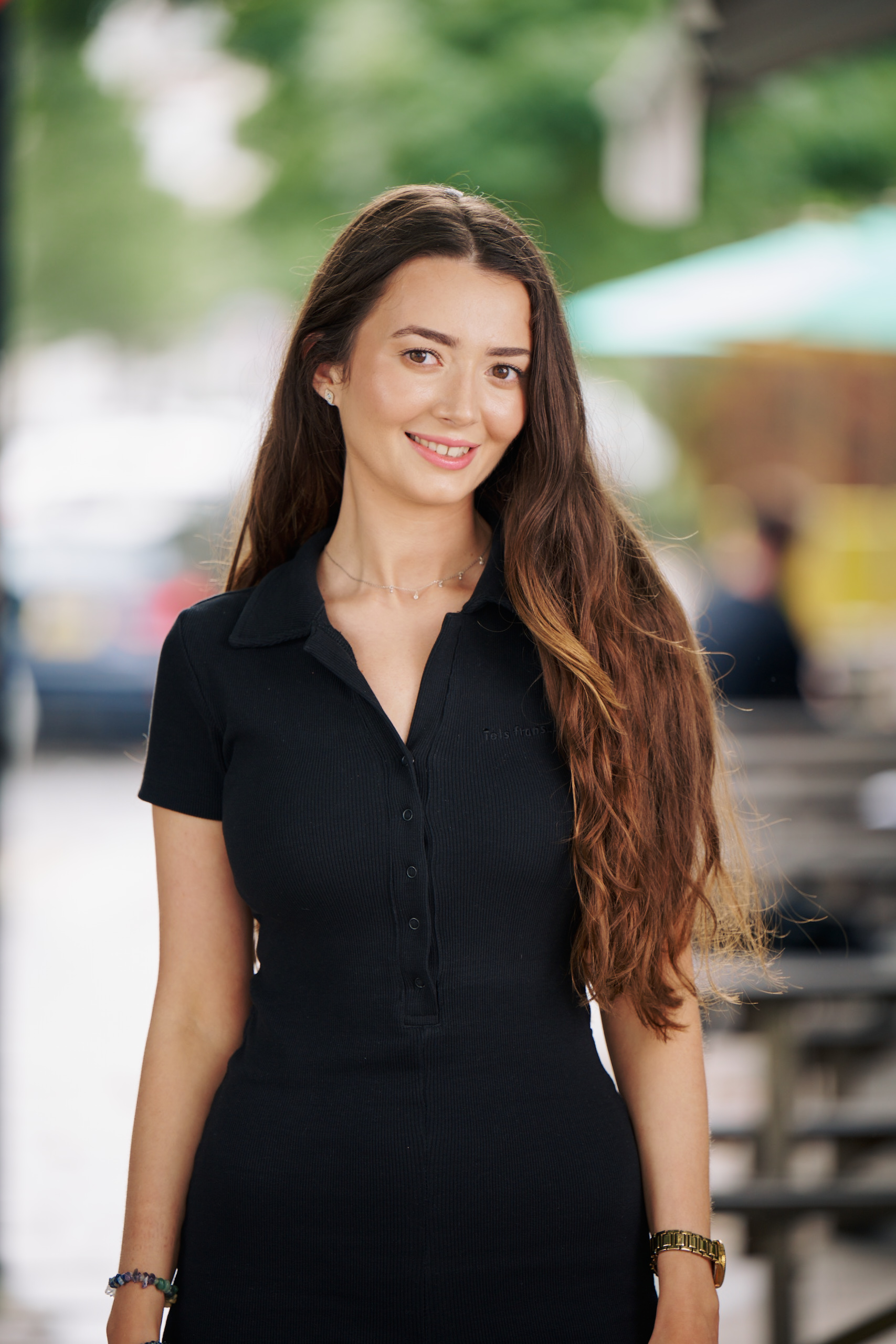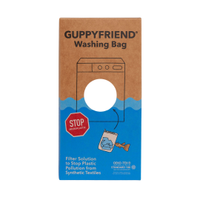Heard about microplastics but not sure what they actually are? Your guide to the dangers they pose, plus how to avoid them
The tiny plastics are more harmful than you'd imagine.


Googling, "what are microplastics?". By now, you'll likely have heard that there are microplastics in both the ocean and in humans, too. But how? Why? And since when?
All good questions - so let's start with the basics. As Madhuri Prabhakar, eco-expert and Beat the Microbead campaigner explains, microplastics are loosely defined as plastic particles that are smaller than 5mm.
So why are they significant? Simply put, because microplastic pollution is harming our oceans, soils, and bodies, too. We're using more plastic than ever, and according to Surfers Against Sewage, there are "approximately 51 trillion microscopic pieces of plastic [in the ocean], weighing 269,000 tons - about the same as 1345 adult blue whales or 500 times the number of stars in our galaxy."
One study found microplastics are in 80% of humans, too. Below, our team of eco-experts explain how to deal with and avoid them in your day-to-day life. Don't miss our guides to calculating your carbon footprint and sustainable living, while you're here.
What are microplastics? Your guide
What's the definition of a microplastic?
As above - tiny, minuscule beads of plastic that can be found in our ocean, food, and even bodies. As Prabhakar explains, there are two different types.
1. Primary microplastics
Primary microplastics are the not-so-obvious sources of microplastic pollution.
"They are called primary microplastics because they are intended to be manufactured at microplastic size," Prabhakar continues. "Often, they're intentionally added to products such as cosmetics, personal care products, detergents, cleaning products, paints."
Marie Claire Newsletter
Celebrity news, beauty, fashion advice, and fascinating features, delivered straight to your inbox!
2. Secondary microplastics
Secondary microplastics are likely the ones that first come to mind when you think of microplastics - the tiny plastic particles. As the name suggests, they're simply bigger plastics broken down into tiny pieces.
Prabhakar explains that these are known as secondary microplastics because they became microplastics as a secondary purpose - they're never meant to become them, rather, as sustainability pro Ashlee Piper explains, they're the "byproduct of industrial plastic waste and consumer plastic materials breaking down into small pieces or even smaller particles."
Shockingly, they're usually found in the ocean and the air. "That's what makes these small particles so insidious - they're literally everywhere and unavoidable," explains Piper.
So, what are the side effects of microplastics?
Aka, should we worry about microplastics? "Absolutely," Piper tells us. "Plastic proliferation is one of the most challenging and harmful issues to people, animals, and the planet," she explains.
They've even found microplastics and still in-tact plastic bags in the deepest known part of the world, the Mariana Trench, which is 37,000 feet deep.
Are there microplastics in the ocean?
Yep - and the stats are quite shocking. "One in three fish caught for human consumption contains plastic", the Surfers Against Sewage website reveals. Prabhakar adds that microplastics are damaging to marine life because marine animals often mistake them for food.
Every day, approximately eight million pieces of plastic pollution find their way into our oceans, according to the OSPAR. While this is heartbreaking for the fish who feed on the plastic, it's also damaging for humans who eat the fish.
"They are passed along the marine food chain, and since humans are ultimately at the top of this food chain, we also eat these plastic particles," shares Prabhakar.
On top of that, plastic is very persistent, and once microplastics enter the marine environment, they're near impossible to remove, he continues. With 12 million tonnes of plastic poured into the ocean every year, it's no surprise microplastics have made their way into the human body.
Are there micrplastics in the soil?
So fish... and now soil, too? How? Simple - microplastics made it into soil through plastic mulches and other materials used in agriculture such as irrigation pipes, shares the expert. The tiny plastics can even enter soils through the plastic coating of synthetic fertilizers and seeds, as well as sludge and sewage, explains Ellen Fay from the Sustainable Soils Alliance.
Fay explains that even organic farming sometimes uses plastic instead of herbicides to suppress weeds, which can cause plastic remnants to remain in fields.
12.5 million tonnes of plastic is used in agricultural production annually - a stat which the Sustainable Soil Alliance is using to encourage the government to put industry measures in place (microplastics in the soil can be damaging to both planetary and human health).
"Microplastics in soils can enter the food chain through plant root systems and animal grazing - which may, in turn, have disruptive impacts on human endocrine systems," explains Fay. "These microplastics can also end up in our waterways through soil runoff."
Are there microplastics in humans?
Finally - yep, you guessed it - microplastics are in humans now, too. One recent study found that 80% of humans have microplastics in their body in some capacity.
"Scientists from Vrije Universiteit Amsterdam published a study in the peer-reviewed journal Environment International which shows that microplastics were found in almost 80 per cent of the sample of people tested," shares Prabhakar.
So, how? In Prabhakar's eyes, it's no surprise as humans have unintentionally infiltrated every corner of the planet and used it to our own advantage. The microplastics are an unwanted byproduct.
"Our recent study found that nine out of 10 cosmetic products contained microplastics," Prabhakar, who is also part of The Plastic Soup Foundation, shared with us.
Bottom line: microplastics have been found in many products, including seafood, water, fruit, and vegetables - and in both indoor and outdoor air, too. We eat, drink and breathe microplastics every day - so much so, plastics have even been found in human placentas and blood.
So, are microplastics harmful?
The question on everyone's lips. As Piper explains, plastic is everywhere and it's becoming a part of our physiology as we consume and breathe it in - so is it damaging?
"Some plastics can contain carcinogenic compounds, while others can absorb unwanted chemicals including heavy metals, polychlorinated biphenyls (PCB's), and pesticides that they then transit into our bodies," she continues. These have the potential to cause serious health issues down the line, but the research is limited as it's a new phenomenon.
Unfortunately, that is not the end of it. As microplastic is small enough to enter cells or tissues, they could cause inflammation, allergic response and even cell death. But bottom line? We simply don't know yet. "The fact is, we're so mired in plastics that we don't yet even know the full longitudinal impact of such exposure," Piper goes on.
Prabhakar agrees, adding that it's likely that microplastics can cause inflammation, DNA damage, and cellular damage, among others. But there are still many uncertainties - like how many microplastics are entering our bodies daily, and to what extent these accumulate in our bodies.
How to avoid microplastics: 10 expert tips
1. Wash your clothes less often
Simple. Plus, when you do put them in the washing machine, make sure to wash them at a lower temperature, so they shed fewer microplastics.
2. Get a guppy bag
Alternatively, get a guppy bag or something similar to catch microplastics in your clothing (think polyester and other synthetics) from entering water systems when you do laundry.
Guppyfriend Washing Bag, £25 | Whistles
Titled the first pragmatic solution to prevent microplastic pollution from washing synthetic clothes - use it in your normal wash.
3. Watch out for plastic in your beauty
To avoid microplastics in cosmetics, try downloading the Beat the Microbead app - it's free to use and the fastest way to know if your cosmetics contain microplastics. Or, read our Beauty Ed-approved list of plastic-free beauty, here.
4. Aim for non-plastic
Try to use non-plastic reusable products at home to avoid exposure to potentially harmful chemicals used in plastic products.
5. Track your plastic footprint
Our guide to tracking your carbon footprint will help, or download the My Little Plastic Footprint app, which aims to help you reduce the amount of plastic you use.
6. Buy natural ingredients
Try to opt for items made from natural materials like cotton, linen, or hemp in clothing and furnishings, and plastic-free when shopping.
When food shopping, this might include going for package-free bulk items you can refill with your own containers, items packed in metal, glass or paper, or items from the farmer's market with no packaging at all. Read our guide to the benefits of eating organic, here.
7. Eat less seafood
Another way to avoid microplastic consumption? Try and reduce your consumption of seafood. Much of ocean-bound plastic comes from plastic fishing nets, and shellfish have been shown to retain a significant amount of microplastics.
So whether you're looking to stop the plastic infestation at its source or avoid ingesting nano plastics, cutting seafood out can be helpful on both fronts. This vegan diet guide is full of handy transition tips.
8. Reduce your packaging
Another top tip: opt for items with no packaging or non-plastic packaging whenever possible, like shampoo bars, stainless steel safety razors, bamboo toothbrushes, and natural tooth tabs.
9. Reduce nanoplastics
Did you know? Regular vacuuming, dusting, and air purifying can help with the proliferation of microplastics in the air in your home.
10. Reuse your bottles and cups
With less than a third of all plastic in the UK recycled, one of the simplest things you can do is use reusable water bottles and coffee cups. Carrying a KeepCup often means you get a discount on teas and coffees, too.
Dionne Brighton is a writer at Marie Claire UK, specialising in all things shopping, beauty and fashion. Born and raised in North London, she studied Literature at the University of East Anglia before taking the leap into journalism. These days, you can find her testing out the latest TikTok beauty trends or finding out what the next full Moon means.
